Iowa’s skies are adorned with the captivating presence of diverse hawk species, each contributing to the state’s vibrant ecosystems. You’ll encounter a rich tapestry of avian wonders amidst the rolling landscapes and woodlands.
In Iowa, ten distinct species of hawks grace the skies, showcasing a remarkable variety of sizes, colors, and hunting strategies.
From the powerful Northern Goshawk to the swift, sharp-skinned hawk, these birds of prey play crucial roles in maintaining ecological balance, controlling rodent populations, and adding dynamic beauty to the natural scenery.
Join us on a journey through the Hawkeye State as we unveil the unique characteristics and lifestyles of these ten awe-inspiring hawk species that call Iowa home. Stay sharp.
10 Hawks In Iowa
Check out the diverse world of hawks inhabiting the skies of Iowa. Each species contributes uniquely to the ecological balance, from the powerful and secretive Northern Goshawk to the swift and agile Sharp-shinned Hawk.
Explore their distinctive characteristics, habitats, and roles in maintaining the health of Iowa’s ecosystems.
1. Red-tailed Hawk
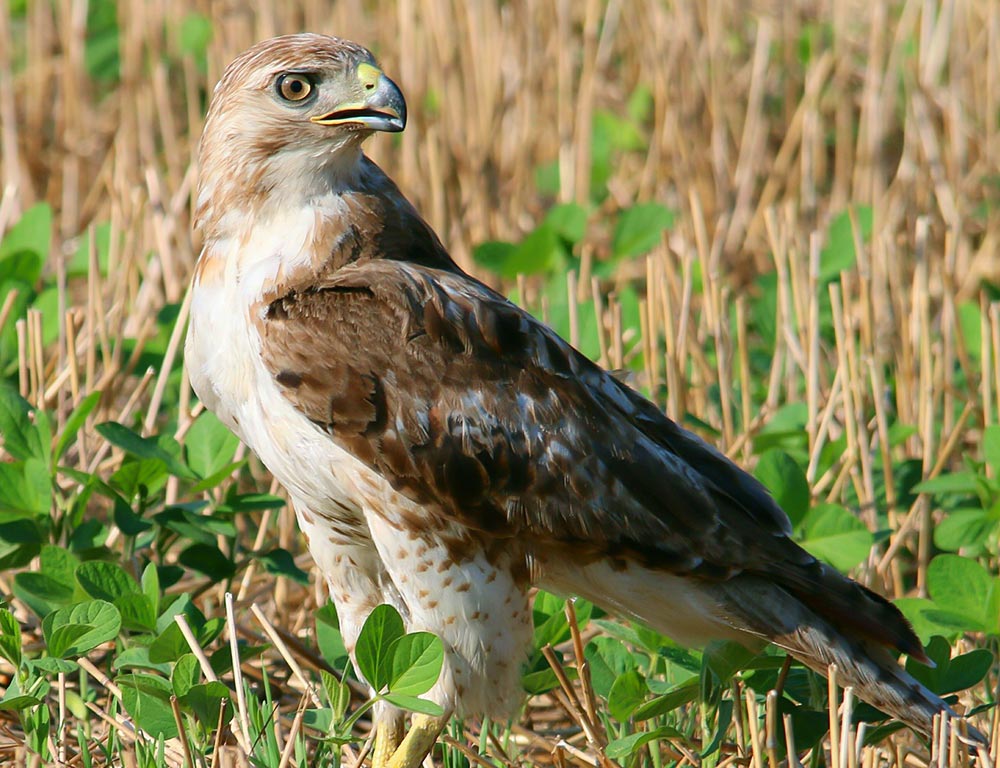
- Scientific name: Buteo jamaicensis
- Population: Widely distributed across North America, including Iowa.
- Life span: Typically around 10 to 20 years.
- Size: Length of about 18-26 inches.
- Weight: Adults weigh between 1.5 to 3.5 pounds.
- Food: Carnivorous diet, preying on small mammals, birds, and reptiles.
- Wingspan: Ranges from 3.3 to 4.8 feet.
- Status: Common and not currently considered at risk.
The Red-tailed Hawk’s distinctive brick-red tail is a common sight in Iowa’s skies. These birds are known for their broad wings and keen eyesight, making them exceptional hunters.
Their lifestyle revolves around soaring high in the sky, using updrafts and thermals to spot prey. Red-tailed Hawks are adaptable and can be found in various habitats, from open fields to wooded areas.
They build large stick nests high in trees or on cliffs. As skilled predators, they play a crucial role in controlling rodent populations, helping to maintain a balance in the ecosystem.
2. Northern Harrier
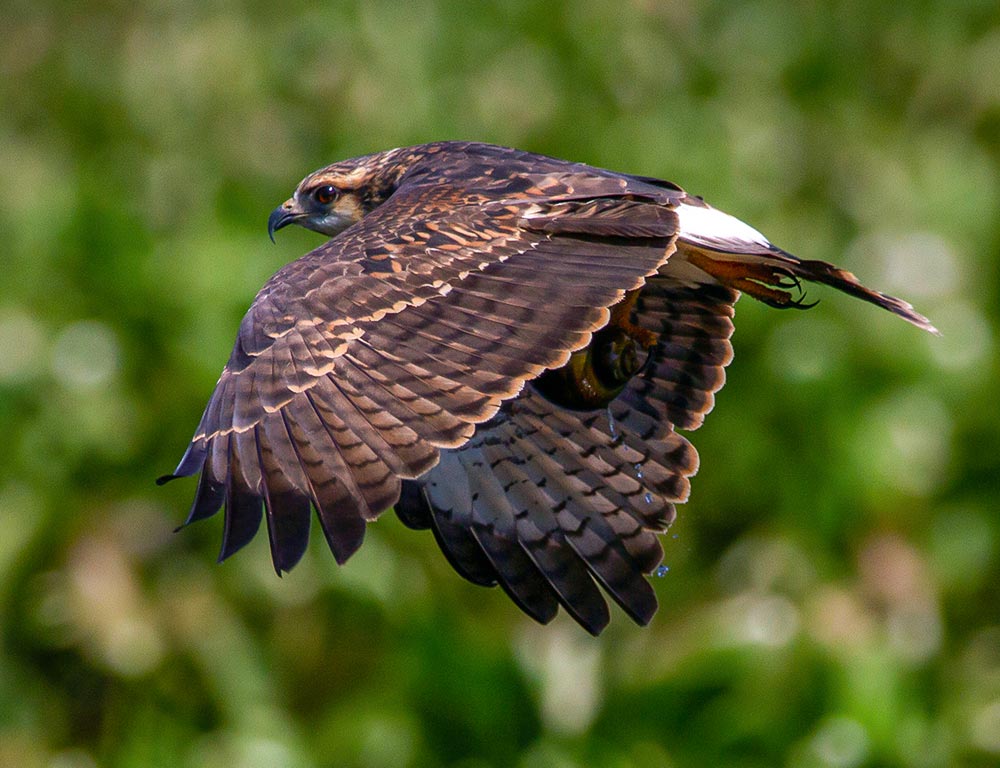
- Scientific name: Circus hudsonius
- Population: Common in North America, including Iowa.
- Life span: Around 12 years in the wild.
- Size: Length ranges from 18 to 20 inches.
- Weight: Females weigh around 17 ounces, males around 12 ounces.
- Food: Primarily preys on small mammals and birds.
- Wingspan: Approximately 38 to 48 inches.
- Status: Generally stable and not currently at risk.
The Northern Harrier is easily identified by its distinctive facial disk and owl-like appearance. These hawks have a unique hunting style, gliding low over open fields and marshes, using their keen hearing and vision to locate prey.
They are known for their agility and can hover over a specific spot, making them efficient hunters. Northern Harriers build nests on the ground in tall grasses.
Their lifestyle is closely tied to open landscapes, where they can find their preferred prey, and they play a valuable role in controlling rodent populations.
3. Cooper’s Hawk
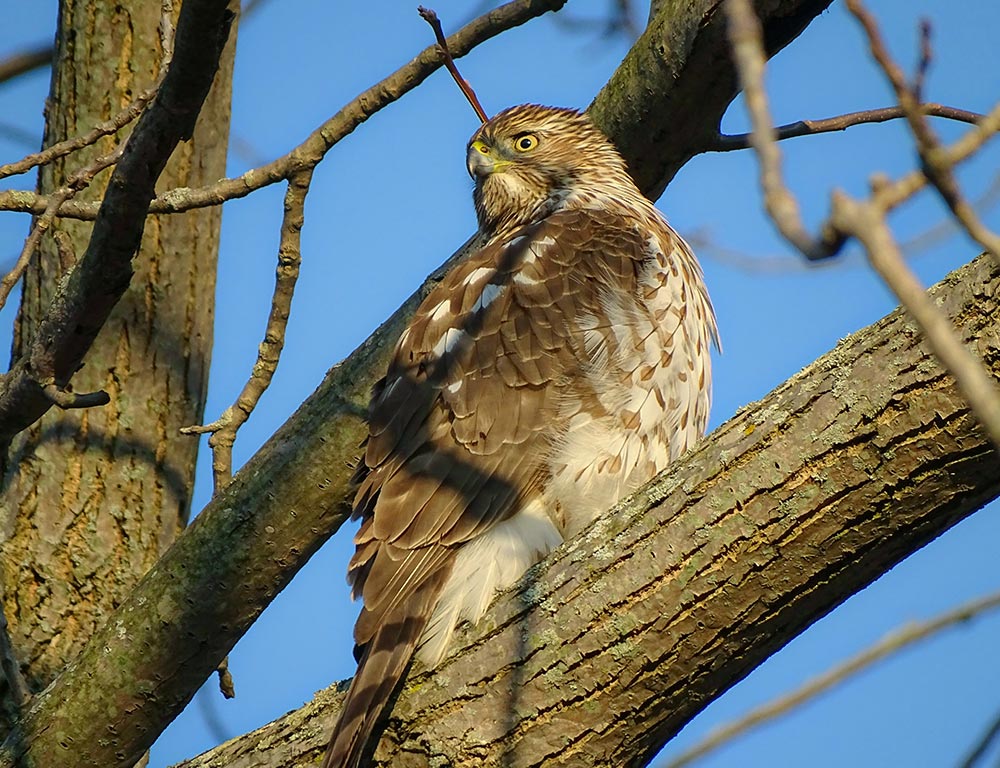
- Scientific name: Accipiter cooperii
- Population: Found throughout North America, including Iowa.
- Life span: Typically around seven years in the wild.
- Size: Length ranges from 14 to 20 inches.
- Weight: Adults weigh between 7 to 24 ounces.
- Food: Primarily preys on birds, with a preference for medium-sized species.
- Wingspan: Approximately 24 to 35 inches.
- Status: Common and not currently considered at risk.
The Cooper’s Hawk is known for its swift and agile flight, making it a skilled hunter of birds. With a preference for wooded areas, these hawks navigate through trees and shrubs to surprise their prey.
Their lifestyle involves high-speed pursuits through dense vegetation, showcasing their remarkable maneuverability.
Cooper’s Hawks build nests in trees and display strong territorial behavior. As predators of birds, they contribute to maintaining a balance in avian populations, preventing the overpopulation of certain species.
4. Northern Goshawk
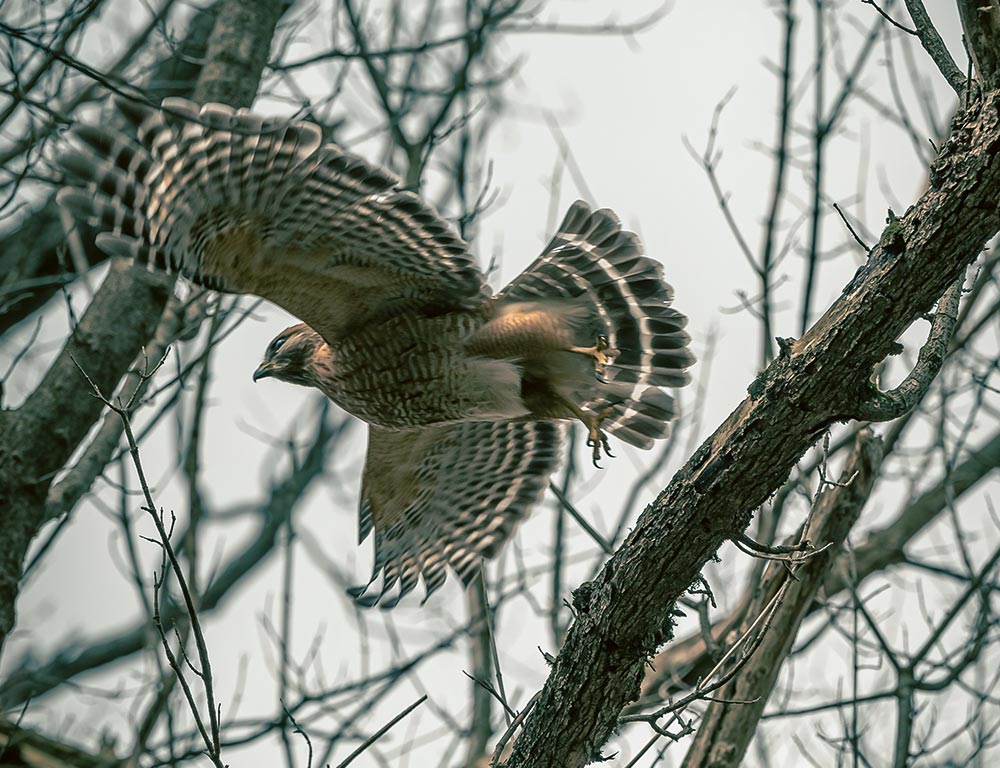
- Scientific name: Accipiter gentilis
- Population: Found in North America, including parts of Iowa.
- Life span: Typically around 8 to 10 years.
- Size: Length ranges from 20 to 27 inches.
- Weight: Adults weigh between 1.5 to 3.5 pounds.
- Food: Mainly prey on birds and mammals, including larger prey like hares and squirrels.
- Wingspan: Approximately 3.3 to 4.5 feet.
- Status: Generally stable but can be affected by habitat loss.
The Northern Goshawk is a powerful and secretive hawk known for its broad wings and short tail. They inhabit dense forests, and their lifestyle involves navigating through the trees with great agility.
These hawks build nests in the high branches of coniferous trees, displaying strong territorial behavior. Northern Goshawks are skilled hunters, using surprise and speed to capture prey.
Their adaptability to various forested habitats makes them a versatile species, contributing to the ecological balance by controlling populations of birds and mammals.
5. Red-Shouldered Hawk

- Scientific name: Buteo lineatus
- Population: Common in the eastern and western parts of North America, including Iowa.
- Life span: Typically around 10 to 15 years.
- Size: Length ranges from 16 to 24 inches.
- Weight: Adults weigh between 1 to 2 pounds.
- Food: Carnivorous diet, preying on small mammals, reptiles, and amphibians.
- Wingspan: Approximately 2.5 to 3 feet.
- Status: Generally stable, but habitat loss can impact local populations.
Identified by its distinctive reddish-brown shoulder patches, the Red-Shouldered Hawk is a common inhabitant of woodlands and forests. Their lifestyle involves perching in elevated positions and scanning the surroundings for prey.
They build nests in the high branches of trees near water sources. These hawks are vocal and territorial, with their distinctive calls echoing through their habitats.
Red-shouldered hawks play a significant role in controlling small mammal populations and contribute to ecosystems’ health.
6. Ferruginous Hawk
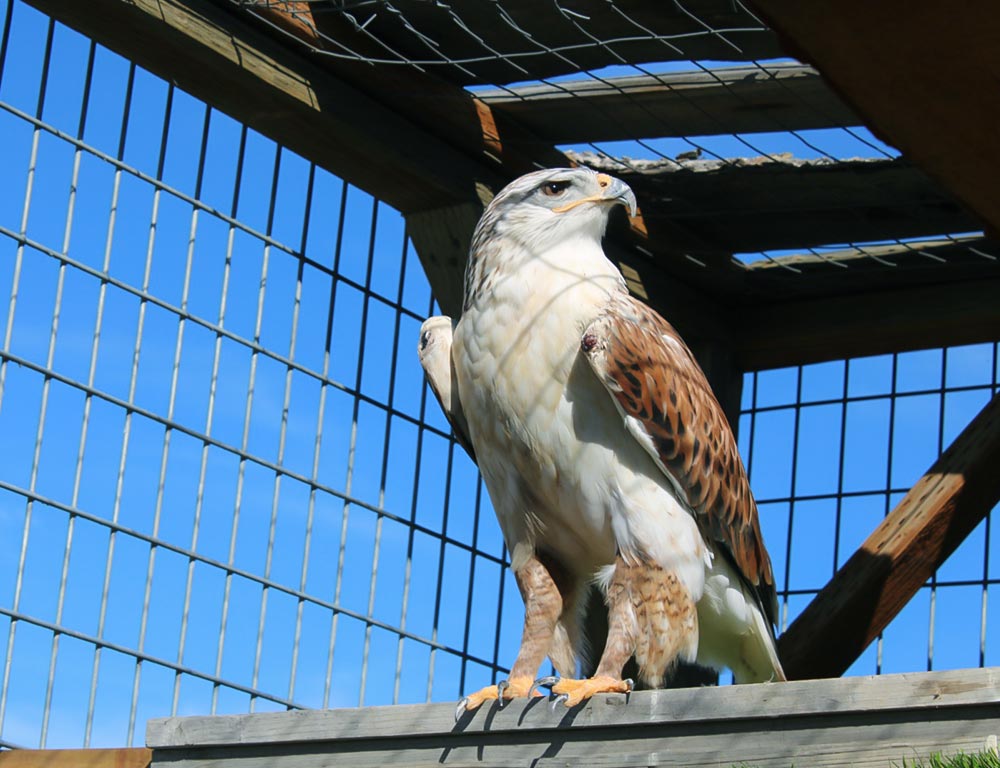
- Scientific name: Buteo regalis
- Population: Found in North America, including parts of Iowa.
- Life span: Typically around 8 to 12 years.
- Size: Length ranges from 20 to 27 inches.
- Weight: Adults weigh between 2 to 5 pounds.
- Food: Primarily preys on ground-dwelling mammals, including rodents and ground squirrels.
- Wingspan: Approximately 4 to 4.5 feet.
- Status: Generally stable but vulnerable to habitat changes and human activities.
The Ferruginous Hawk is the largest hawk in North America, recognized by its light coloration and rusty-red markings.
Their lifestyle revolves around open landscapes, where they can spot prey from the air. Ferruginous Hawks build nests on cliffs or in trees, and their breeding success is closely tied to the availability of suitable nesting sites.
As predators of ground-dwelling mammals, they contribute to controlling rodent populations, playing a crucial role in maintaining ecological balance.
7. Sharp-shinned Hawk
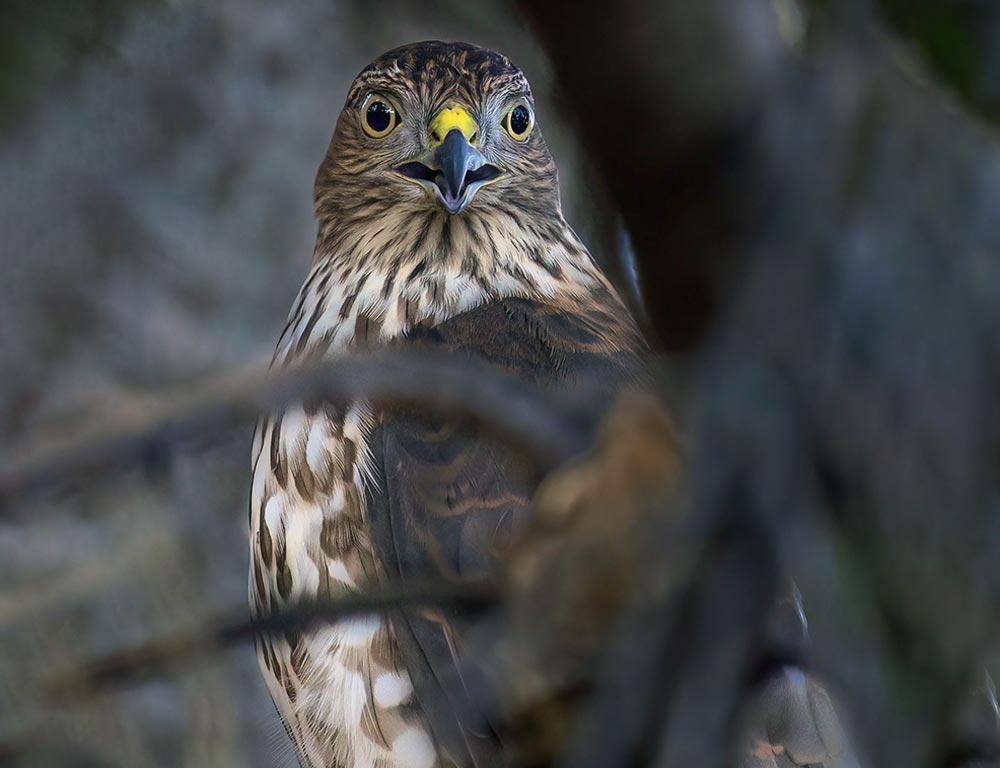
- Scientific name: Accipiter striatus
- Population: Widespread in North America, including Iowa.
- Life span: Typically around 4 to 6 years.
- Size: Length ranges from 9 to 14 inches.
- Weight: Adults weigh between 3 to 7 ounces.
- Food: Primarily preys on small birds.
- Wingspan: Approximately 1.5 to 2 feet.
- Status: Common and not currently considered at risk.
The Sharp-shinned Hawk is a small and agile bird of prey with a distinctively short tail.
Their lifestyle involves fast, low flights through woodlands and urban areas as they pursue small birds. Sharp-skinned hawks build nests in trees and demonstrate strong territorial behavior.
They are known for their adaptability and can be found in various habitats. As specialized bird hunters, they contribute to maintaining a balance in bird populations and regulate avian communities.
8. Broad-winged Hawk
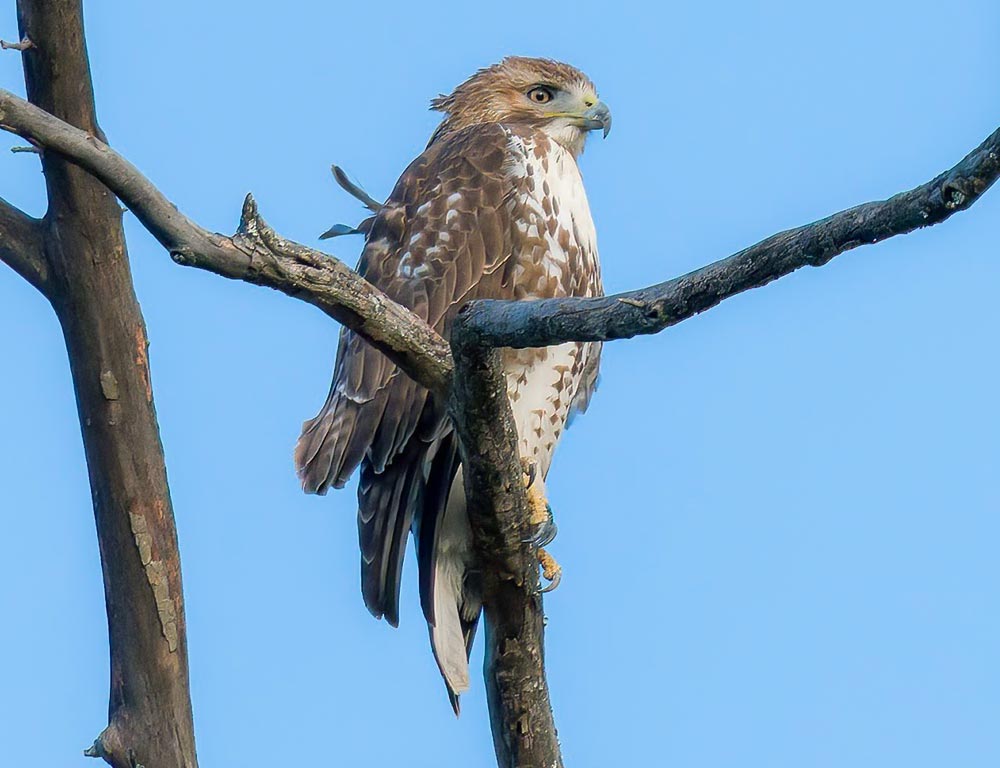
- Scientific name: Buteo platypterus
- Population: Common in eastern North America, including parts of Iowa.
- Life span: Typically around 4 to 6 years.
- Size: Length ranges from 13 to 17 inches.
- Weight: Adults weigh between 9 to 20 ounces.
- Food: Primarily preys on small mammals, reptiles, and amphibians.
- Wingspan: Approximately 2.5 to 3 feet.
- Status: Generally stable, but habitat loss can impact local populations.
The Broad-winged Hawk is a medium-sized hawk with a distinctive barred tail and broad wings. Their lifestyle involves navigating through dense woodlands, where they can find their preferred prey.
These hawks build nests in the high branches of deciduous trees. They are known for their migratory behavior, often forming large flocks during migration, and their distinctive high-pitched calls can be heard as they soar through the skies.
Broad-winged Hawks play a significant role in controlling populations of small mammals, contributing to the health of forest ecosystems.
9. Swainson’s Hawk
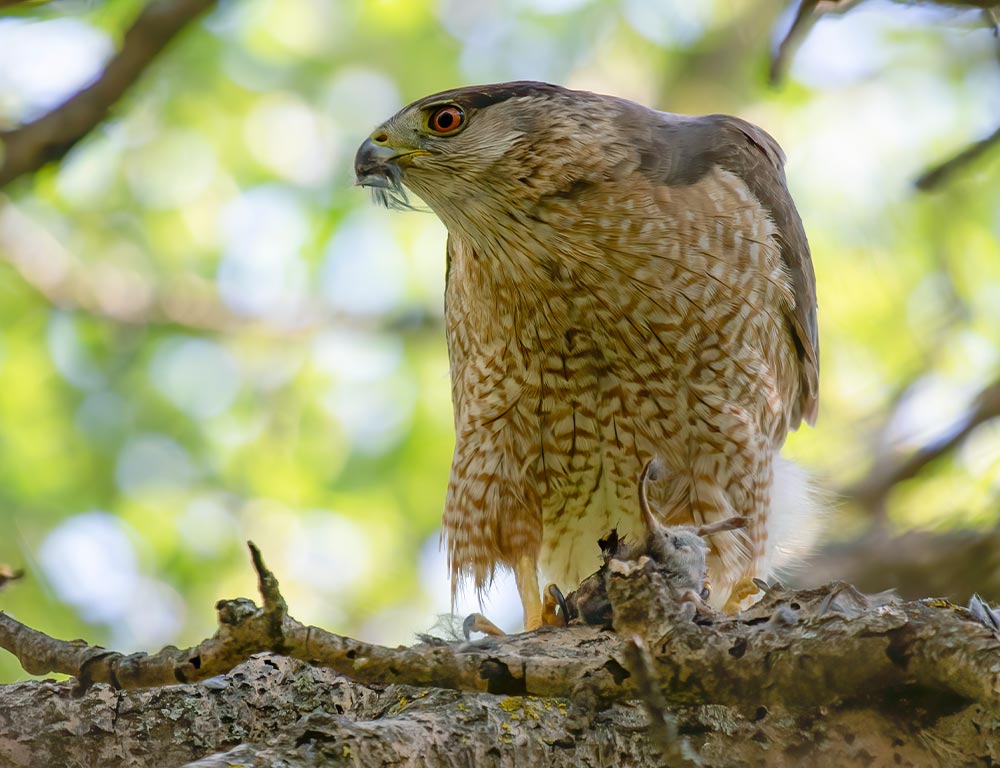
- Scientific name: Buteo swainsoni
- Population: During migration, it was found in western North America, including parts of Iowa.
- Life span: Typically around 7 to 10 years.
- Size: Length ranges from 18 to 22 inches.
- Weight: Adults weigh between 2 to 3.5 pounds.
- Food: Primarily preys on rodents and insects.
- Wingspan: Approximately 4.5 to 5 feet.
- Status: Generally stable, but habitat loss and pesticide exposure can affect populations.
Swainson’s Hawk is a medium-sized buteo known for its distinctive white chin and throat. Their lifestyle involves foraging in open grasslands and agricultural areas.
They build nests in trees or on utility poles. Swainson’s Hawks are notable for their long-distance migrations, traveling from North and South America to the grasslands of Argentina.
During migration, they often form large flocks called “kettles.” These hawks are vital in controlling rodent populations in their breeding and wintering grounds.
10. Rough-legged Hawk
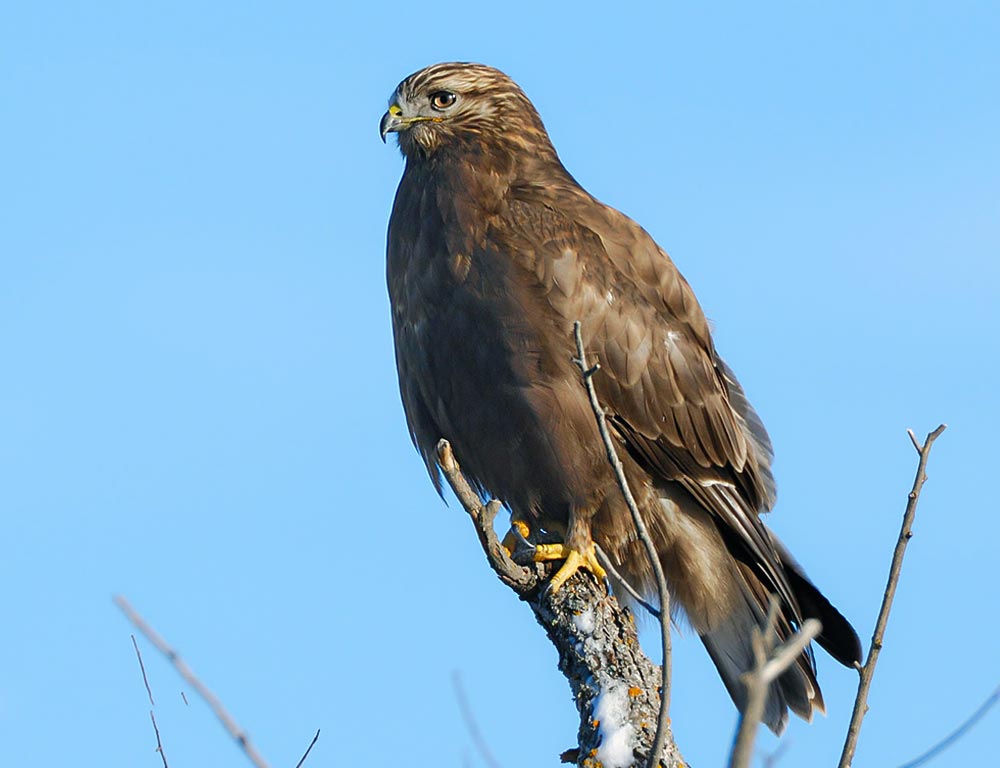
- Scientific name: Buteo lagopus
- Population: Found in northern North America, including parts of Iowa during winter.
- Life span: Typically around 10 to 15 years.
- Size: Length ranges from 18 to 24 inches.
- Weight: Adults weigh between 2 to 3.5 pounds.
- Food: Primarily preys on rodents, especially lemmings.
- Wingspan: Approximately 4.5 to 5 feet.
- Status: Generally stable but vulnerable to habitat changes and climate impacts.
The Rough-legged Hawk is easily identified by its feathered legs, an adaptation to cold northern climates. Their lifestyle involves hunting over open areas, including marshes and tundra. They build nests on cliffs or on the ground.
Rough-legged Hawks are known for their migration, traveling long distances between their breeding grounds in the Arctic and wintering grounds in more southern regions.
During winter, they can be spotted in parts of Iowa, where they contribute to controlling rodent populations in open landscapes.
Where to Spot Hawks In Iowa?
Embark on a captivating journey to spot hawks in the picturesque landscapes of Iowa.
From woodlands to open fields, Iowa offers diverse habitats for these majestic birds. Here are some locations where you can witness the awe-inspiring presence of hawks in their natural environment:
Effigy Mounds National Monument
Embark on a journey through the lush woodlands surrounding Effigy Mounds National Monument.
Here, the landscape tells a story of ancient cultures, and hawks find abundant prey amidst the towering trees in the rich ecosystem tapestry.
Wander the trails that wind through sacred grounds, where these majestic birds of prey showcase their hunting prowess, adding a dynamic layer to the historical and natural wonders of the monument.
Yellow River State Forest
Navigate the intricate trails of Yellow River State Forest, an expansive realm of woodlands that serves as an idyllic haven for hawks.
As you explore, witness the intricate dance of these birds of prey, hunting and nesting in the undisturbed corners of the forest.
The forest’s serene atmosphere provides a perfect backdrop for observing the elegance and power of hawks as they navigate the tree-lined trails, creating a harmonious blend of nature’s beauty and the wild essence of these avian inhabitants.
Loess Hills State Forest
Ascend the unique topography of the Loess Hills, where the landscape’s rolling contours create an unparalleled vantage point for observing hawks in flight.
As you stand atop these ancient hills, watch the graceful silhouettes of hawks soaring against the vast sky, becoming a part of the natural spectacle that unfolds over the hills.
The Loess Hills State Forest offers a truly immersive experience for hawk enthusiasts, combining breathtaking views with the awe-inspiring presence of these raptors.
Des Moines River Valley
Follow the meandering path of the Des Moines River Valley, a landscape that unveils the hunting prowess of hawks in open fields and along the riverbanks.
As you traverse the valley, observe the intricate aerial displays of these birds as they scan for prey, adding a dynamic energy to the tranquil beauty of the surroundings.
The Des Moines River Valley becomes a living canvas painted with the vivid hues of hawks in flight, offering a unique perspective on their role in the intricate web of Iowa’s ecosystems.
Neal Smith National Wildlife Refuge
Immerse yourself in the diverse habitats of Neal Smith National Wildlife Refuge, a sanctuary where hawks and many bird species thrive.
Wander through wetlands, prairies, and woodlands, discovering the interconnectedness of nature. Here, hawks find refuge and contribute to the delicate balance of the refuge’s ecosystems.
With every step, witness the symbiotic relationship between these powerful birds and the rich biodiversity that calls Neal Smith National Wildlife Refuge home.
Maquoketa Caves State Park
Embark on a captivating journey to Maquoketa Caves State Park, where hawks grace the skies above the wooded areas surrounding unique cave formations.
As you explore the park, look to the treetops and cliffs, where these aerial predators showcase their mastery of the air.
The juxtaposition of the hawks against the park’s geological wonders creates a mesmerizing spectacle, making Maquoketa Caves State Park a captivating destination for those seeking the perfect blend of avian beauty and geological marvels.
Wrapping Up
In the heartland of Iowa, the skies are graced by the majestic presence of hawks, each species weaving its story into the rich tapestry of the state’s ecosystems.
From the stealthy Northern Goshawk to the swift, sharp-skinned hawk, these birds of prey play a crucial role in maintaining the delicate balance of nature.
Whether you explore the woodlands of Effigy Mounds or the open fields along the Des Moines River Valley, each location holds a unique charm for hawk enthusiasts.
The diverse landscapes, from Loess Hills to Maquoketa Caves, offer a glimpse into the lives of these incredible creatures, showcasing their adaptability and significance in Iowa’s ecological framework.
As you venture into these habitats, hawk’s soaring silhouettes and distinctive calls create an unforgettable symphony, leaving an indelible mark on your journey through Iowa’s avian wonders. Best of luck.